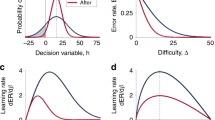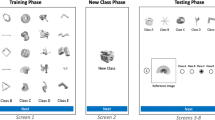Key Points
In this part, we will discuss making sure your CPD meets the following requirements:
-
It is satisfying identified needs in the people involved
-
It is helping the organisation meet its objectives
-
It is evaluated to ensure that learning was achieved
-
Something has changed as a result of the training that will produce benefits (ideally) to both the individual trained and the organisation.
Abstract
If your people are your most expensive resource (and they are) then it is incumbent on you to ensure that they are fully trained to perform their jobs effectively
Similar content being viewed by others
Main
The most important question we should ask about virtually any business operation or expenditure is: Am I getting value for money? If you are not, then it would seem sensible to stop. If you are, you feel you can continue with confidence.
This apparently obvious dose of commonsense seems to disappear when the subject of training comes up. Evaluation of training of people within an organisation is often forgotten totally. Instead training is carried out on occasions to satisfy a feeling that it 'ought to be done' and is often the first thing to be cut when a reduction in expenditure is contemplated.
All of this raises the important and obvious point: if your people are your most expensive resource (and they are) then it is incumbent on you to ensure that they are fully trained to perform their jobs effectively. If they are not then you are wasting your investment, often substantially.
The role of evaluation of training in CPD
As was discussed in the first part of this series the importance of evaluation of training takes on a new significance when we consider the role of CPD. If we need to demonstrate that we are keeping up-to-date by carrying out CPD then surely we need to ensure that we are gaining the maximum benefit as well. People simply carrying out CPD to complete the form with the right number of credits are wasting their own time, the time of those providing the CPD, and the time of those imposing the CPD (if that is the case).
In other words – if you have to carry out some form of CPD to satisfy the requirements of the GDC then the least you can do is gain the maximum benefit from it as well. Not to do so is both stupid and wasteful.
Thus you need to be sure that the CPD you embark on meets the following requirements:
-
It is satisfying identified needs in the people involved
-
It is helping the organisation meet its objectives
-
It is evaluated to ensure that learning was achieved
-
Something has changed as a result of the training that will produce benefits (ideally) to both the individual trained and the organisation.
The five levels of evaluation
There are five basic levels of evaluation which are summarized in Figure 1. Most dental training involves Level 1 (reaction to the event) but goes no further. In smaller organizations (such as dental practices) Levels 4 and 5 can probably be combined, but in larger organizations they should be considered separately.
Reaction to the event
It is a sad fact that the majority of people attending training courses have no objectives in their minds before they come
The first level of evaluation is the reaction of the trainee to the event itself. In formal training (such as a course, workshop or seminar) people are often provided with 'evaluation forms' to complete at the end of the event. In more informal training (on-the-job, reading a book or completing a distance-learning programme) even this basic level is usually omitted.
Evaluation forms at the end of courses are really more for the benefit of the organizer of the event itself (which is why they are handed in) and play very little part in the trainee's own evaluation. In some cases a member of staff may return after a course to be asked by the manager 'How was the course?'. The common reply of 'It was okay, but the food was poor' is totally worthless, and the most value the manager might get is a negative comment on a course, which would raise doubts about the wisdom of sending someone else on the same course.
To gain some value from this level of evaluation the manager should probe more deeply into the specific details of why the course was good/bad to enable a measured decision to be taken in the future. In the case of a less formal method of training Level 1 evaluation would possibly strengthen the fact that this method of learning is appropriate or inappropriate for a particular individual's learning style.
However, it is more appropriate for any Level 1 evaluation to be combined with Level 2 evaluation if more benefit is to be gained.
Were your objectives achieved?
The pre-event meeting:
-
Why is the training happening?
-
Is it still relevant?
-
What are the objectives for people/person being trained?
Level 2 evaluation checks to see if the individual's objectives were achieved. It is a sad fact that the majority of people attending training courses have no objectives in their minds before they come, as any trainer running courses will tell you. Thus, in order for this level of evaluation to have a meaning the trainee needs to have set some objectives prior to the learning event.
This can be done at a 'pre-event meeting' and would normally occur a day or two before the trainee attends the event. In the case of a dentist the meeting could be carried out with a colleague, or practice manager. In the case of a nurse or receptionist the dentist or practice manager would probably talk to the trainee to identify any objectives, depending on who has line-manager responsibilities for the individual.
The meeting need not be formal, and can often take a couple of minutes. The person attending the event would be reminded to check why he or she was attending the event, whether the original reason was still relevant, and what they wanted to gain out of the event. This would focus them on making sure they clarified whether the course covered their need (which should have been identified earlier anyway) and what questions to ask of the trainer to help them meet their objectives. In some cases the individual might need to seek help in the natural breaks (by asking the trainer directly) or by asking questions at appropriate times during the course itself.
Many course brochures are over-optimistic in advertising the benefits to be gained from attending the course, and it is usually wise to contact the organizers before the course to check on specific items or subjects. This will ensure that the course content will indeed help meet the objectives of the people attending.
Thus the evaluation of this level can occur a day or two following the event to check if the objectives had been met and how the trainee plans to put what he or she has learnt into effect.
What has changed as a result of the training?
This is really the crux of the evaluation. Too often people have training sessions or attend courses and then return to work and carry on behaving exactly as before. In this situation one could legitimately question the value of the training, which is why so much training is totally wasted.
After all, what is the point of taking a day off routine work to attend a course (with all the costs involved, both direct and indirect) if nothing changes afterwards?
Thus this level of evaluation should occur a few weeks after the training to see what has changed as a result of the training. In some cases the time between the training and the evaluation should be less, but there must be a time lag to allow the trainee to think about what needs to change, to try out some ideas and to discover what works best.
This stage is so important that the programme of CPD the BDJ is currently developing will contain a way of helping people evaluate their CPD at Level 3.
How has the training benefited the team/organization?
This level of evaluation checks that the training was related to helping achieve the business objectives of the organization. It completes the loop that started with the training needs analysis that ensured that the training should be linked to the business objectives by checking back to ensure it has.
For example, does the behaviour change of the trainee contribute positively towards better profitability or better customer care? Is the receptionist's manner on the telephone (following the training) resulting in more appointments for consultations? Are the new systems in place producing better staff motivation? Do more patients pay for their treatment on time following the training?
As stated earlier in larger organizations you may want to differentiate between departmental or team objectives and the objectives of the organization as a whole. For example at the BDJ the objectives for training the editorial staff are very relevant to the production of the BDJ itself (Level 4) but also contribute to the overall objectives of the BDA (Level 5). In smaller organizations such as dental practices these two levels will often be combined into one.
Conclusion
Evaluation of training is vital to ensure that the training is both cost-effective and maximized. People will often not see all the benefits of their training unless they have time to think it through, ideally with the help of a colleague or manager.
Author information
Authors and Affiliations
Corresponding author
Additional information
Refereed paper
Rights and permissions
About this article
Cite this article
Grace, M. Evaluating the training. Br Dent J 191, 229–230 (2001). https://doi.org/10.1038/sj.bdj.4801149
Published:
Issue Date:
DOI: https://doi.org/10.1038/sj.bdj.4801149
This article is cited by
-
British Dental Journal based Continuing Professional Development: A survey of participating dentists and their views
British Dental Journal (2005)
-
Attitudes and trends of primary care dentists to continuing professional development: a report from the Scottish dental practitioners survey 2000
British Dental Journal (2002)




